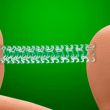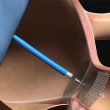The DAPT study concluded that continued thienopyridine plus aspirin beyond a year after coronary angioplasty is associated with a decrease in the rate of stent thrombosis and major cardiovascular events. In contrast, there is a significant increase in moderate to severe bleeding when compared with continued aspirin alone. Based on the outcomes of this and...
TCT 2017 | SENIOR: DES with a Bioresorbable Polymer and Short Dual Antiplatelet Therapy in Elderly Patients
Courtesy of the SBHCI. This study sought to assess the safety and efficacy of an everolimus-eluting stent with a biodegradable polymer (SYNERGY II) vs. a conventional stent (REBEL) in patients >75 years old with short duration of dual antiplatelet therapy. Before randomization, investigators recorded the planned duration of dual antiplatelet therapy (1 month for stable patients and 6 months...
Dual antiplatelet therapy discontinuation causes more thrombotic events at 12 months
Several randomized studies have shown that dual antiplatelet therapy (DAPT) is as effective to prevent thrombotic events in the segment treated with PCI, as it is with the rest of the coronary segments. This is very clear. The problem is there are a series of adverse events following P2Y12 inhibitor discontinuation. This phenomenon called rebound effect, happens...
Never ending controversy over the duration of post DES dual antiplatelet therapy
Original title: Second Generation Drug-Eluting Stents Implantation Followed by Six Versus Twelve-Month – Dual Antiplatelet Therapy- The SECURITY Randomized Clinical Trial. Reference: Antonio Colombo et al. J Am CollCardiol. 2014 Nov 18;64(20):2086-97. The optimal duration of dual antiplatelet therapy after second-generation DES implantation is still debated and apparently will remain controversial for some time. The aim of this...
Risks and benefits of Dual Antiplatelet beyond the year of a drug-eluting stent
Original title: Twelve or 30 Months of Dual Antiplatelet Therapy after Drug-Eluting Stents. Reference: Laura Mauri et al. N Engl J Med 2014;371:2155-66. Dual antiplatelet therapy is recommended after a drug-eluting stent to prevent thrombotic complications. The clinical benefit of this scheme it is not clear beyond one year. Patients were registered to receive a...
Drug-Coated Balloons (DCB): Sirolimus vs. Paclitaxel in De Novo Lesions in Small Vessels
The use of drug-coated balloons (DCB) offers the advantage of avoiding permanent stent implants, thus reducing the incidence of in-stent restenosis (ISR), neoatherosclerosis, and late in-stent thrombosis. Additionally, the use of DCB reduces the duration of dual antiplatelet therapy. Current evidence supports the use of DCB for ISR treatment (Class I) compared with drug-eluting stents...
Crisis and Socioeconomic Disparities: Relationship with Recurrent Events After Myocardial Infarction
Socioeconomic status (SES) has been linked to recurrent atherosclerotic cardiovascular disease events (rASCVD) after myocardial infarction (MI). However, patients with low SES are underrepresented in most randomized studies. This may be largely due to a higher incidence of metabolic syndrome, insufficient use of recommended medication, such as statins, for secondary prevention and insufficient participation in...
Should We Start Thinking Again About Bioresorbable Stents?
Coronary revascularization with drug-eluting stents (DES) is very frequent, especially in acute coronary syndromes, but these metallic stents are permanent foreign bodies that activate the entire inflammatory system. Using bioresorbable stents (BRS) emerged as an alternative to this challenge. Although the initial results of the ABSORB study were not as expected (probably due to a...
Should Aspirin Be the Standard of Secondary Prevention of MACE?
Much has been published recently on short term dual antiplatelet therapy (DAPT) both in acute (ACS) and chronic coronary syndrome (CCS) as well as safety of P2Y12 inhibitor monotherapy. When discussing secondary prevention in patients with established coronary artery disease, aspirin (ASA) has been the preferred drug for the prevention of new atherothrombotic events. This...
Should We Use Left Atrial Appendage Occlusion More Frequently? What Real-Life Data Are Available?
Left atrial appendage occlusion (LAAO) is an alternative to prevent atrial fibrillation stroke mainly used in patients at high risk for bleeding. One of the most widely used devices in randomized trials is the Watchman, which yielded promising results. However, its real-life performance had yet to be analyzed. Researchers conducted an analysis of the National...









